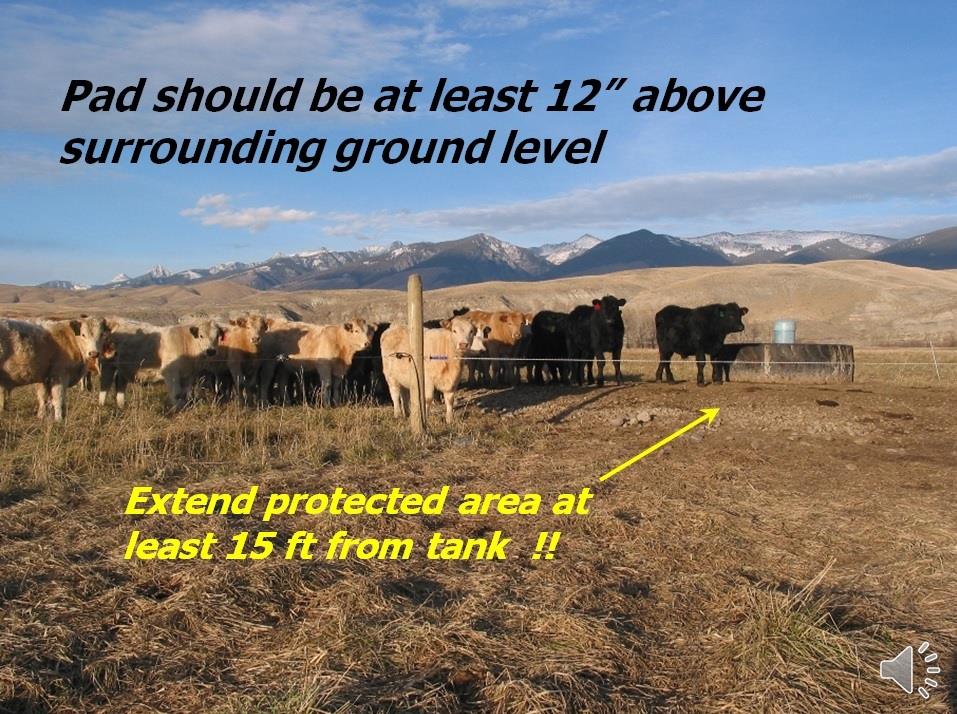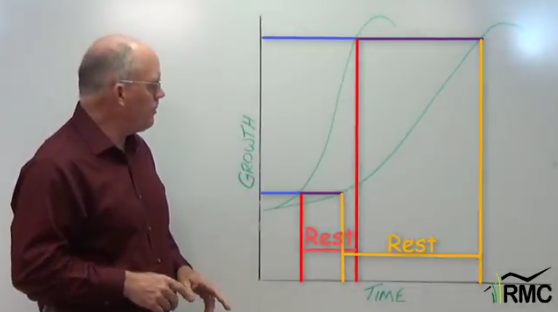I’ve learned these do’s and don’ts of stock tank installations over the course of my life and am sharing them so you can learn from my experience.
The main ‘do’ is to create a pad on which to place your tank. This provides a flat place for the cattle to stand and they don’t move the rock away from the tank. The main ‘don’t’: Do not install the tank at grade level and then push rock up to it. That is a surefire recipe for developing a mud hole and starting a foot-rot problem.
It costs some more money to make good installation up front, but it will save you money in the long run due to lower maintenance costs and healthier livestock.
This is how we like to install our tanks. We learned from making mistakes the first time around. We generally use a water block system with the tank located at the center.

The top of the pad is flat for at least 8 ft out from the edge of the tank and then tapers down to the surrounding grade. Good drainage and solid footing make life a lot better down on the ranch.
We don’t use concrete pads under any of our waterers. Here is what can happen when you skimp on concrete. In this case a low quality valve in the tank malfunctioned and ran water out overnight. Because only the front feet of the cattle were on the pad, they dug out everything around it in just a few hours time.

Yes, the pad was above grade, but it wasn’t large enough to prevent damage around the tank. Dirt packed up to the edge of the concrete has very little stability. Unless many tons of rock are hauled in here, this installation will continue to be a problem year in and year out.
Here is a brand new installation that is a wreck waiting to happen. The base is too small and too steep. The cattle will have this rock tramped down into a donut in a matter of weeks and there will be no drainage for either rainwater or spill over.

This is a tank installed on the same ranch four years earlier. They have already hauled in a couple truckloads of rock to replace what the cattle stomped down and pushed to the sides of the water block. Note the standing water behind the tank. That is rainwater that has nowhere to go because the tank was installed at grade and the cattle created a levee to prevent drainage.

Another chronic problem with these tank-at-grade and then mound rock to the tank installations is the short tank side. In a hot environment this is an open invitation to cattle to take a swim. Note the cage over the tank valve to prevent cattle in the tank from breaking the valve. Why not install the tank in a manner that cattle won’t step into the tank?

I have to admit this is at the ranch unit we manage in Idaho. That was 12 years ago when we put these in as tank-at-grade & mound rock to the tank installations.

Here’s the same tank after the cattle turned the surrounding water to brown shitty water later in the summer. Look at all those cows back there saying, “What, you want me to stand in that mess?!?”

This is why it is important to learn from your mistakes. This tank has a near perfect donut levee all the way around it & cattle getting a drink have no choice but to stand in the sloppy mess. Significant foot-rot problems resulted.
Solution? Install the tank right the first time and don’t make the same mistake twice.






Does the Dev. Guide have suggestions for controlling moss in tire tanks?
Hi Jerry. The guide does not cover keeping tanks moss free. Not a problem in our area as the water is generally too cold to grow a good moss crop. I have been told from several sources, but have not done it myself, that putting a wad of copper wire in the tank will control moss. That is generally done by stripping the insulation off of old romex and putting about 50-100 ft of wadded up wire in the tank. If it works, it is a relatively simple & low cost method. Good luck. Jim
Sharon, We have not had the problem of perching birds, but we also don’t have ‘guardrails’ around the tanks. I do like your idea of the rotating pipe to prevent them from perching. Jim
What do you do about buzzards and ravens perching on troughs and fouling them? More of a problem with troughs in the open. I plan to try to install future tanks nearer trees or something to perch on. But these are already here. I have considered trying 2 sizes of pipe with the outer pipe rolling when they try to perch. These are round metal troughs so not as easy as straight sides to work with. Has anyone else had this problem?
Comments are closed.